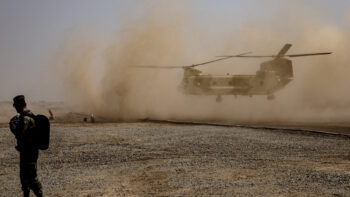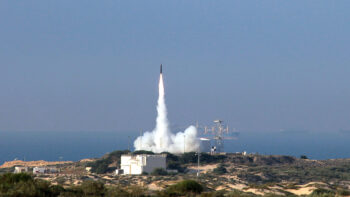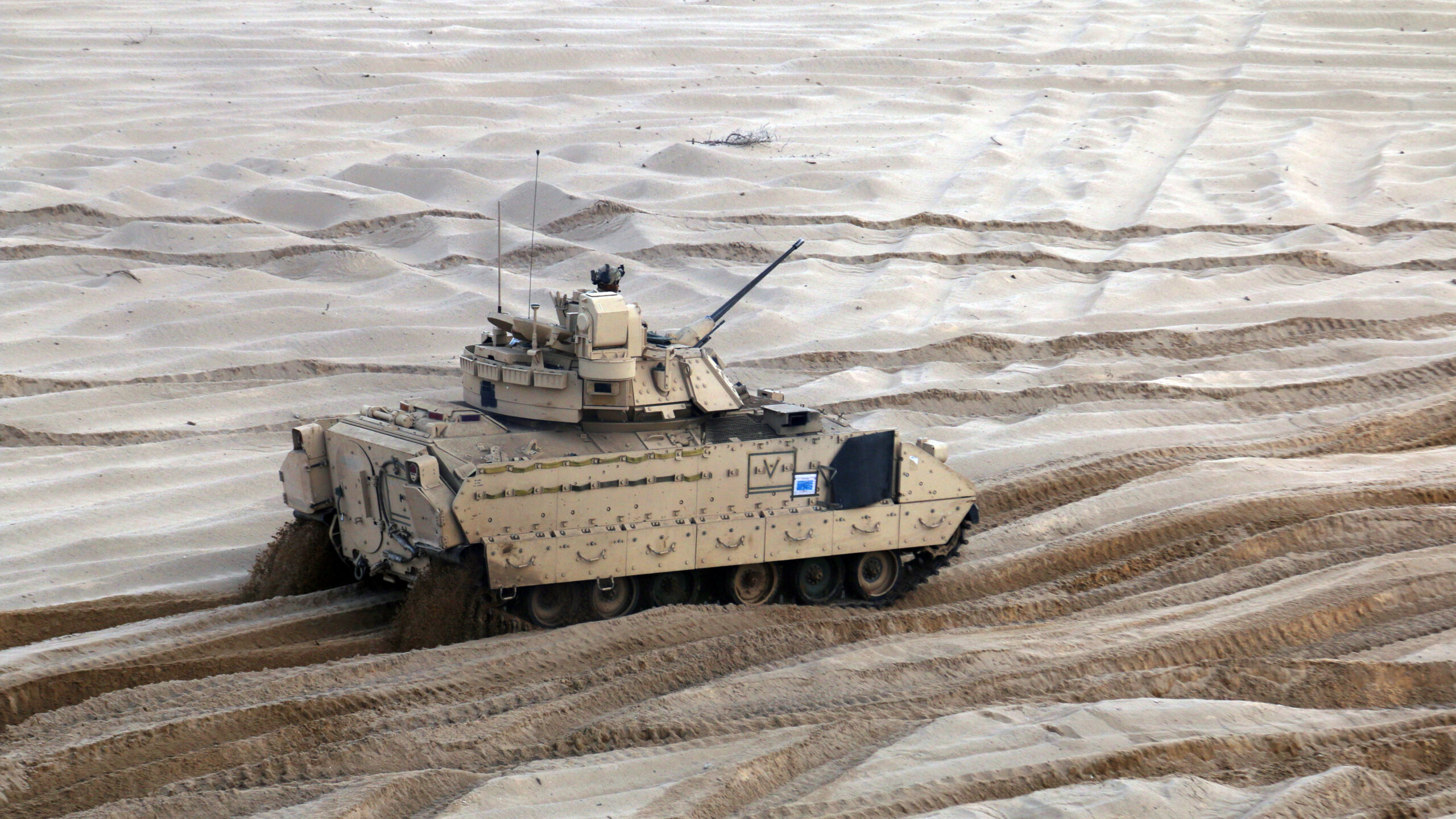
An M2A3 Bradley Fighting Vehicle from 5th Squadron, 4th Cavalry Regiment, 2nd Armored Brigade Combat Team, 1st Infantry Division, moves into position to conduct a firing systems check at the Presidenski Range, Trzebian, Poland. (US Army/ Staff Sgt. Wallace Bonner)
WASHINGTON — It’s again down to American Rheinmetall and General Dynamics Land Systems (GDLS) for who will build the Army’s M2 Bradley infantry fighting vehicle replacement, after the service announced today that those two teams are the only ones moving forward in the high-profile race.
Under the Optionally Manned Fighting Vehicle (OMFV) competition, five teams two years ago received contracts to produce concept designs for the service. The service then reopened the competition to all interested parties and, based on those proposals submitted late last year, have now whittled the list down to two names. Rheinmetall and GDLS will split the $1.6 billion development funding pot and the ultimate winner may lay claim to a $45 billion production deal, the Army said.
“I think we are on much firmer ground this time, from an achievable realistic requirements standpoint,” Army acquisition chief Doug Bush told reporter today.
“This is our at least third, maybe fourth, attempt to replace the Bradley and this one’s going to succeed,” he later added.
BAE Systems, Oshkosh Defense, and Point Blank Enterprises are not receiving additional dollars to proceed, and service officials today did not disclose how many additional companies submitted ultimately unsuccessful bids. It was also not immediately clear if one or more of those companies would protest the decision but Bush said the service has “anticipated that potentiality.”
Today’s announcement is a slight change in plans for the service, which had previously it may select three companies to proceed with the next two program phases. In the end, the Army decided that would be too pricey.
“Focusing our resources on two ensures that both will be properly funded: it was a resource informed decision, but one that also lets us retain competition,” Bush said. “It’s kind of… a sweet spot between the two demands we had.”
The duo will now embark on the next two program phases and ultimately lead to what’s expected to be a single winner. For the next phase, Phase 3, the teams will be tasked with focusing on detailed design activities to mature their vehicle blueprint. This phase is expected to culminate in a critical design review that leads into Phase 4, or prototype build and test activities.
It is during this period where the two teams will build and test up to 11 prototypes each (seven for a contract award with an option for four more), along with two ballistic hulls and turrets, armor coupons, and digital model twins, according to a solicitation issued in July 2022 and Maj. Gen. Glenn Dean, the program executive officer for ground combat systems.
If the Army and industry can successfully make it through that performance period, the service intends to select one team to proceed with low-rate initial production in 2027, with the intent of achieving the first unit equipped milestone in 2029 ahead of full-rate production.
In separate statements to Breaking Defense, both winning teams praised today’s announcement.
Gordon Stein, GDLS’s vice president and general manager of US operations, said his team is “proud” of its innovation, research, development and investment for the program.
“Our highly affordable XM30 development approach maximizes performance to the Army’s requirements, and delivers a vehicle that is purpose-built for the mission,” Stein added. “Our XM30 was designed from its inception in our digital engineering environment, allowing efficient and agile integration of transformative capabilities on a platform that embodies the Army’s vision for the ground combat systems common infrastructure architecture.”
Meanwhile, Matt Warnick, American Rheinmetall Vehicle’s managing director, said his company and team is also “privileged and honored” to have been selected.
“Together with our teammates, ARV will deliver a vehicle with the most modern protection, firepower, mobility, and power generation capabilities available, thus ensuring our soldiers dominance on future battlefields,” Warnick added. Rheinmetall’s team includes L3Harris Technologies, RTX, Textron Systems, Allison Transmission and Anduril Technologies.
Just what that future vehicle may look like is a little clearer today, thanks to a new name. No longer officially the OMFV program, Army officials today said it will be dubbed the XM30 Mechanized Infantry Combat Vehicle effort, at least for now.
Brig. Gen. Geoffrey Norman, the director of the next-general combat vehicle cross-functional team, also unveiled new details today, including that the combat vehicle will fit eight soldiers — two crew members and six dismount — and feature a remote turret, the developmental XM913 50-millimeter cannon, anti-tank guided missiles and machine guns. Each team has also proposed its own active-protection system to shoot down incoming aerial threats like rocket-propelled grenades.
Since the service is building the vehicle to be manned by one fewer person than today’s Bradley crew size, Bush said he is keeping is eyes on automation development.
“That two-crew is a big deal and the technologies behind making that successful are going to be [the] thing we’ll watch very closely,” he added, but the Army has to overcome issues with cognitive load, since there’s one less operator.
Additionally, Dean also noted that the service decided to separate the software acquisition pathway to help on that front but said the service will not kick off that acquisition activity until the 2024 to 2025 timeframe.
Time will tell if the Army can succeed this go around in securing dollars and nailing down a design so it can finally get soldiers inside a Bradley replacement vehicle — especially since this is its fourth attempt. After false starts under the Future Combat Systems and Ground Combat Vehicle umbrellas, the Army launched its initial OMFV competition that it ultimately ended up scrapping in January 2020.
A host of factors led up to that decision, including BAE Systems dropping out of the competition and the Rheinmetall team being disqualified. The Army was left with only GDLS’s bid sample, and it ultimately determined that it had a “responsive issue,” and opted to scrap the competition. Army leaders rebounded quickly this time around, and relaunched the OMFV competition with the goal of providing companies with more flexibility to design unique concepts not tied to stringent requirements during the initial phases.
For example, during the concept design phase, the Army provided companies with a list of vehicle “characteristics” instead of firm requirements that some blamed for the derailment of the previous competition. That list included survivability, mobility, growth, lethality, weight, logistics, transportability, manning, and training.
However, during the early phases, a couple of themes emerged that Army program officials now deem essential. The first is the desire for a smaller vehicle, and the second is for it to have a hybrid-electric design, Dean told reporters in October 2022.
“We’ve gone from very large vehicles to much smaller ones along the way and we’ve seen all five current participants go to hybrid-electric designs; that’s a major shift for us,” he added.
Israel likely partner for Greece as it looks for integrated air defense systems
A pair of sources told Breaking Defense that Greece is in the fact-finding process of what systems Israeli might be willing to sell, as Athens looks for multi-layered air defense options.











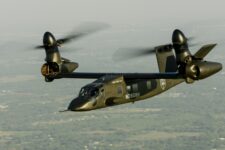
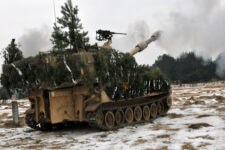




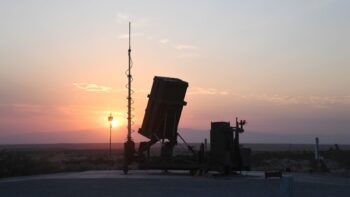




![E-2D_AR_1[1]](https://breakingdefense.com/wp-content/uploads/sites/3/2024/10/E-2D_AR_11-350x233.png)
